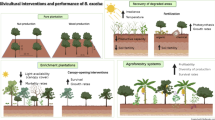Abstract
Black locust (Robinia pseudoacacia L.) was the first forest tree species to be, imported from North America to Europe at the beginning of the 17th century. It is the most important fast-growing stand-forming tree species in Hungary. Black locust plantations can be successfully established in response to a range of economic and ecological opportunities. Plantation survival and productivity are maximized by matching the species’ growth characteristics with silvicultural options and land management needs. In the paper the sequence of forest tending operations in black locust stands is proposed, based on results of long-term stand structure and forest yield trials. Implementing good silvicultural plans and models will lead to profitable black locust stands and greater acceptance of the species by land managers. Black locust would also be a very useful species for energy productions as the related research results have been shown in the paper.
Similar content being viewed by others
References
Führer, E. 1998. Characterization of black locust from ecological aspects [C]. In: Rédei, K. (edit.) Black locust (Robinia pseudoacacia L.) growing in Hungary. Publications of the Hungarian Forest Research Institute, Bp., 10–11.
Halupa, L., Rédei, K. 1988. Forest tending [M]. In: Keresztesi, B. (ed.), The black locust. Academic Press, Budapest, 115–125.
Halupa, L., Gabnai E. 1990. Spacing experiments with newly bred poplar cultivars [J]. Proceedings of the Forest Research Institute,82–83(II): 279–287.
Keresztesi, B. 1988. The black locust [M]. Budapest: Academic Press
Rédei, K. 1984. Yield of black locust stands [R]. Research Report. FRI, Budapest.
Rédei, K. 1997. Handbook of black locust management [M]. FRI, Budapest, (in Hungarian).
Rédei, K. 2001. The impact of initial spacing on the stand structure and yield of black locust (Robinia pseudoacacia L.) stands at, cleaning age. [J]. Silva Balcanica, Sofia,1: 70–78.
Veperdi, G. 1988. Spacing experiments with Austrian pine on sandy sites of South-Plain in Hungary [J]. Proceedings of the Forest Research Institute,80–81: 123–132.
Author information
Authors and Affiliations
Additional information
Biography: Karoly Redel (1952-), Male, Professor, Deputy Director General of Forest Research Institute, H-1023 Budapest, Frankel Leó Str. 42-44, HUNGARY.
Responsible editor: Chai Ruihai
Rights and permissions
About this article
Cite this article
Rédei, K. Management of black Locust (Robinia pseudoacacia L.) stands in Hungary. Journal of Forestry Research 13, 260–264 (2002). https://doi.org/10.1007/BF02860087
Received:
Issue Date:
DOI: https://doi.org/10.1007/BF02860087




